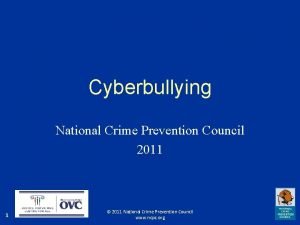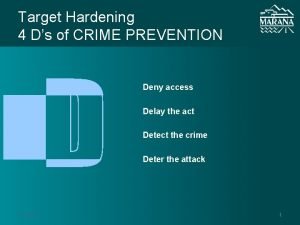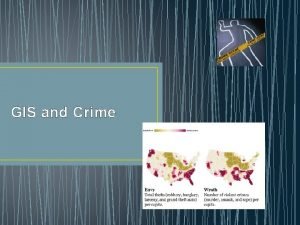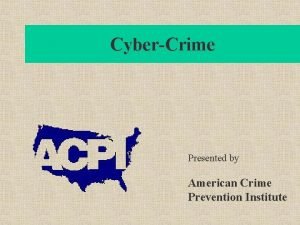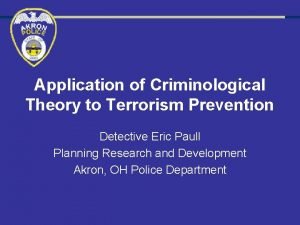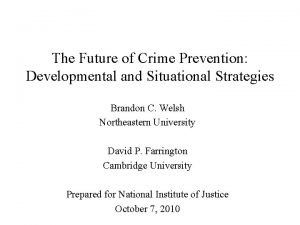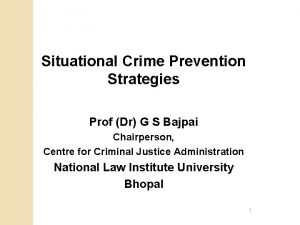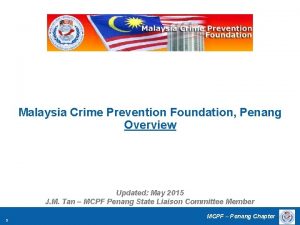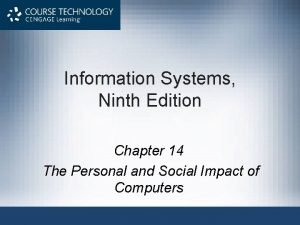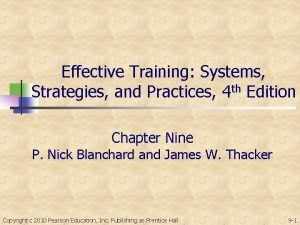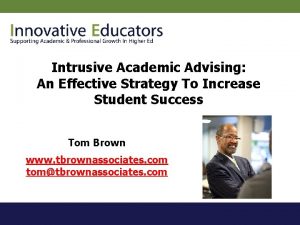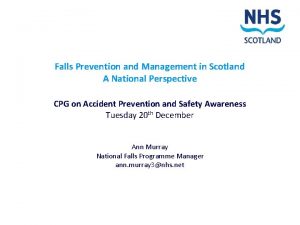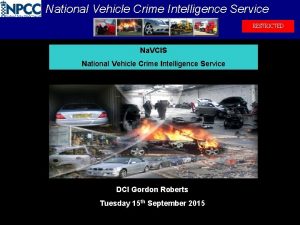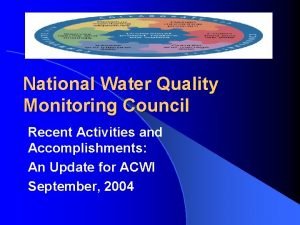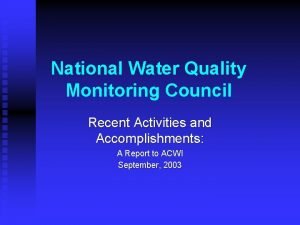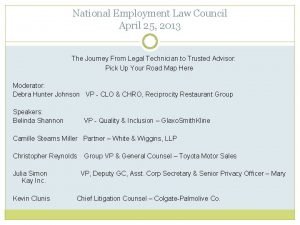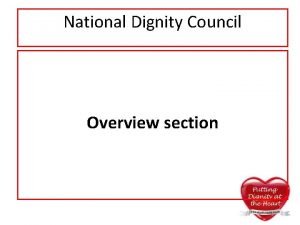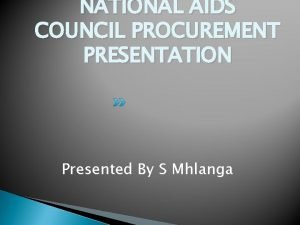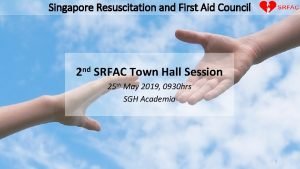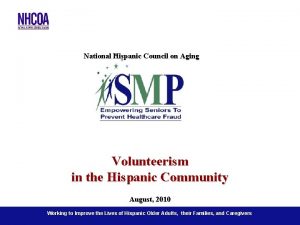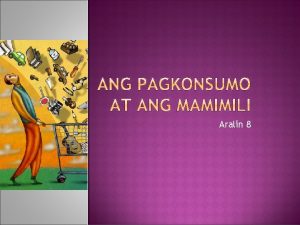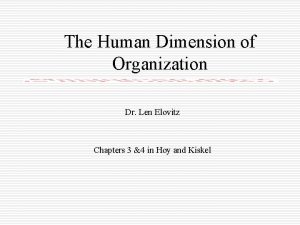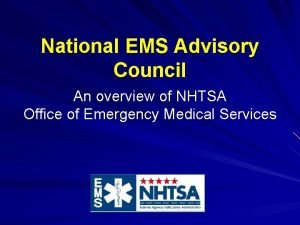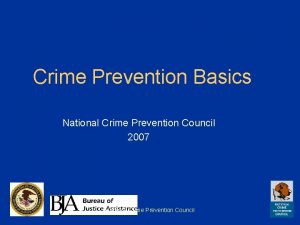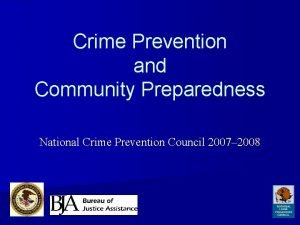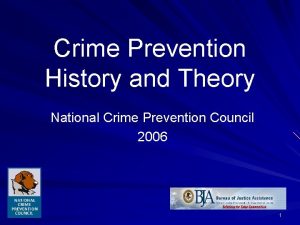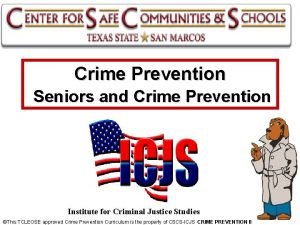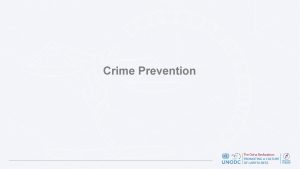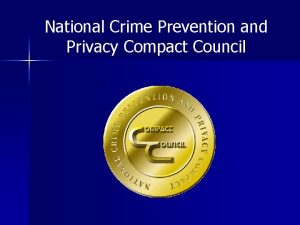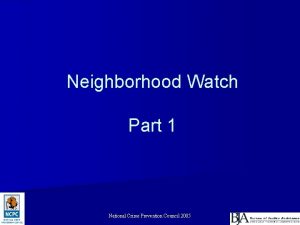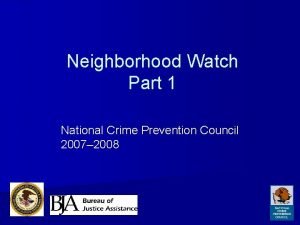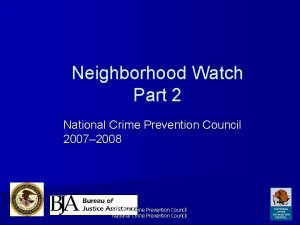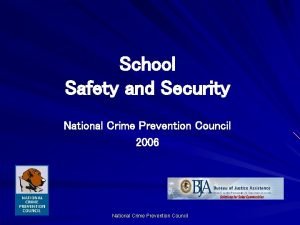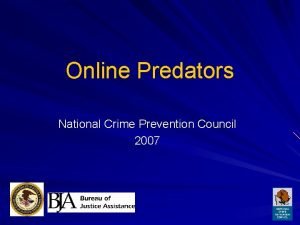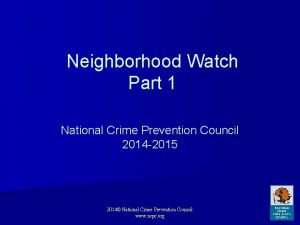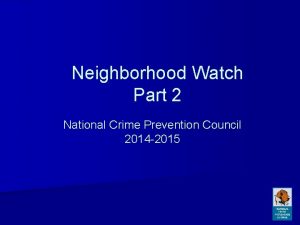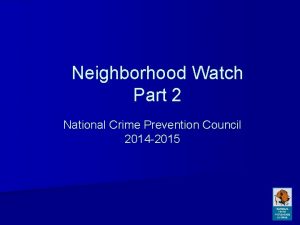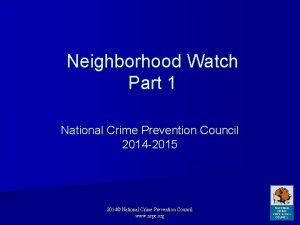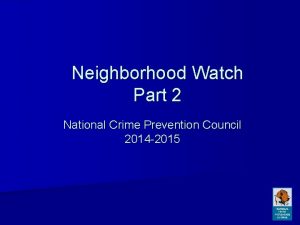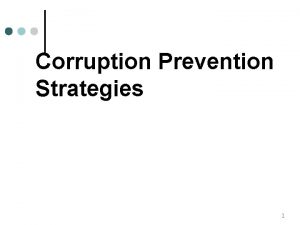National Crime Prevention Council 1 Strategies for Effective






















































- Slides: 54

National Crime Prevention Council 1 Strategies for Effective Communication

National Crime Prevention Council 2 TRUST BUILDING MODEL GREATER SUCCESS ! GREATER FLEXIBILITY AND RANGE OF SOLUTIONS RELATIONSHIP AND PARTNERSHIP BUILDING EFFECTIVE COMMUNICATION TRUST

National Crime Prevention Council 3 THE COMMUNICATION PROCESS • Message cues • Listener supplies meaning • Content • Relate to your audience; build rapport

National Crime Prevention Council 4 THE COMMUNICATION PROCESS (CONTINUED) • One-way or two-way communication • Consider verbal and nonverbal cues • Physical appearance • Solicit student engagement and participation by using openended questions and feedback.

National Crime Prevention Council 5 NONVERBAL COMMUNICATION CONSIDERATIONS • Facial expression • Personal space • Tone of voice • Territoriality • Eye contact • Time • Touch

BUILDING TRUST THROUGH 6 EFFECTIVE COMMUNICATION National Crime Prevention Council • Effective Listening • Listen to learn and understand, not to challenge or persuade. • Take turns and listen for facts and feelings. (Both are important. )

National Crime Prevention Council 7 Six Factors Necessary To Improve Police-Community Relations

National Crime Prevention Council 8 THE SIX FACTORS 1. Membership 2. Environment 3. Process and Structure 4. Communications 5. Purpose 6. Resources

National Crime Prevention Council 9 MEMBERSHIP 1. Appropriate cross-section of members 2. Mutual respect, understanding, and trust 3. Members see that collaboration is in their best interest. 4. Members develop an ability to compromise.

National Crime Prevention Council 10 ENVIRONMENT 1. Political and social climate are favorable. 2. Collaborative group is viewed as a leader in the community. 3. There is a history or evidence of collaboration or cooperation in the community.

National Crime Prevention Council 2. PROCESS AND Members are invested in the process as well as the outcome. STRUCTURE Clear roles and responsibilities 3. Flexibility 4. Adaptability 5. Equal decision-making authority is held by each member regardless of rank, authority, or place in the hierarchy. 11 1.

National Crime Prevention Council 12 COMMUNICATION 1. Members learn to listen and allow venting. 2. There is open and frequent communication. 3. Members disclose self interest at first meeting. 4. Members establish informal and formal means of communication.

National Crime Prevention Council 13 PURPOSE 1. Concrete, attainable goals and objectives 2. Shared vision 3. Desired results and strategies

National Crime Prevention Council 14 RESOURCES 1. A skilled and unbiased convener of meetings 2. Staff time and volunteer time 3. Sufficient funds

CRIME IN YOUR NEIGHBORHOOD A LACK OF COMMUNITY INVOLVEMENT MAY LEAD TO SOME OF THE MOST SERIOUS AND PERPLEXING PROBLEMS YOUR COMMUNITY FACES.

National Crime Prevention Council 16 WHY IS COMMUNITY INVOLVEMENT IMPORTANT? • When members of a community are involved with each other, they know • Their neighbors • The daily “goings-on” in the neighborhood • When something is wrong

National Crime Prevention Council 17 GREAT WAY TO PERPETUATE ONE COMMUNITY INVOLVEMENT IS THROUGH THE NEIGHBORHOOD WATCH PROGRAM.

National Crime Prevention Council WHAT IS THE NEIGHBORHOOD WATCH PROGRAM? Neighborhood Watch was established in 1970 to bring residents 18 • together to interact and become the guardians for the police in their community.

National Crime Prevention Council 19 NEIGHBORHOOD WATCH • Crime prevention group organized around a block, defined neighborhood, or business district • Serves as “eyes and ears” for law enforcement • Helps establish or reclaim informal control of an area by observation, visibility, and increased social interaction • Donates time and resources • Usually has no formal budget or funding source • Success results in reduction in crime and improved quality of life for neighborhood residents

National Crime Prevention Council 20 THE BENEFITS OF NEIGHBORHOOD WATCH • Unites the community and increases neighborhood cohesion • Reduces fear of crime in the community • Improves crime reporting by citizens • Increases surveillance in the community • Prevents and reduces crime • Enhances homeland security

National Crime Prevention Council 21 THE BENEFITS OF NEIGHBORHOOD WATCH (CONTINUED) Studies show that Neighborhood Watch is effective because • It unites neighbors around a common goal—safety and security. • It provides all members basic skills on preventing crime and reporting suspicious activities or crimes. • It builds a base for correcting neighborhood problems. • It works well with other civic activities.

CITIZEN ACTIONS DISCUSS YOUR COMMUNITY’S OVERALL SECURITY, INCLUDING LIGHTING, AND CONTACT NEIGHBORS OR THE PROPER AUTHORITIES TO REQUEST NECESSARY IMPROVEMENTS. CONTACT YOUR LOCAL LAW ENFORCEMENT AGENCY AND WORK WITH IT TO DISCUSS BASIC COMMUNITY MODIFICATIONS THAT MAY OVERCOME CURRENT PROBLEMS.

National Crime Prevention Council HOW CAN CITIZENS BE MORE AWARE? 23 • Be informed • Be alert • Be prepared

COMMUNITY ENGAGEMENT AND PROBLEM SOLVING 24 Communit y engageme nt Partnershi p Problem solving

DISCUSSION – 1 ST PART 25 What is community engagement?

GROUP DISCUSSION 26 What are challenges for the police when engaging with the community?

Lesson structure 27 2 The CHEERS, PIERS and SARA models

PROBLEM SOLVING 28 for problem resolution The CHEERS method for problem identification The SARA model for problem resolution The PIERS model

CHEERS 29 A police officer can use the CHEERS method to help define if a series of events or factors could become a community problem or is already a community problem.

30 CHEERS: SIX ELEMENTS FOR IDENTIFICATION A problem related to SGBV does or could affect the vulnerable members of the Community. People Expect the police to solve the problem The problem keeps Recurring over short or long periods of time. The problem related to SGBV is Harmful to the vulnerable members of the community. There has been more than one Event of a similar type. There is a Similarity between the events or other problems.

PIERS 31 The PIERS Model is a way to bring a comprehensive police response to a problem once it has been identified. It is a generic approach which can be applied to SGBV crimes.

PIERS 32 Prevention I ntelligence Enforcement Reassurance - Prevent and reduce SGBV crimes Improve knowledge on SGBV Investigate SGBV crimes Improve public confidence to report SGBV crimes Support - Improve non-operational police actions, such as training

SARA 33 The SARA method is a continual cycle and is a form of analysing while looking for solutions.

SARA 34 Scanning Assessment Analysis Response It can be used on small or large problems. If you cannot complete one of the steps, you can use the same model to work on that issue until it is resolved.

ANALYZING Who are they and what do they have in common? Why are the victims vulnerable at certain times? Can they protect themselves better? Who are they? OFFENDERS VICTIMS 35 Involves examining How many? information How old are to make they? deductions Access to vehicles and/or and identify weapons? the cause, Do they have and looking gang for reasons associations? behind events.

National Crime Prevention Council 36 VALUE OF COMMUNICATION IN POLICE • https: //www. youtube. com/watch? v=y 5 Iu. R 0 QZnt. A

National Crime Prevention Council 37 TACTICAL COMMUNICATION • Verbal Judo, or tactical communication as it has come to be called, allows a person to work effectively with individuals regardless of the kind of day they are having, circumstances in their personal life, or other influences both positive and negative. • Scenario B in the introduction is one of the many examples in which Verbal Judo can work for police. • It s part of the ’s part of the “S A F E R 8 to 5 S. A. F. E. R. 8 to 5 ” technique. A cornerstone tactic of Verbal Judo that can be adapted to just about any contact.

National Crime Prevention Council 38 8 STEPS TO GOOD COMMUNICATION • 1. Give an Appropriate Greeting Statement: This should be a statement and not a question. • 2. Identify Yourself and your Department: This establishes your legal authority to stop/detain them as required by the 4 th Amendment. Research has also shown that people are less likely to verbally abuse you if they can put a name with a face. • 3. Explain the Reason for the Contact: Makes your justification for the stop clear upfront and clarifies that you are not just harassing some poor citizen while also decreasing complaints of racial profiling. In addition, it is also a requirement of the 4 th Amendment that people have the rig ht to know wh y the y are bein g detained b y the police. • 4. Any Justifiable Reason For [your actions]… Could there be any justifiable reason why they violated the law? • 5. Ask for Identification: This could be a Driver’s License or State ID card containing name an d DOB. These are items th t a are governe d by US Supreme C t our rulings. (Terry vs. Ohio) • 6. Request Additional Information: Examples include… vehicle registration, proof of insurance, etc. • 7. Decision Stage: This is where you decide on what the disposition of your contact will be. • 8. Appropriate Closing Statement

National Crime Prevention Council 39 5 TACTICAL STEPS • Every encounter begins with the Tactical 8 Step approach, however some subjects may require additional verbal persuasion. When the citizen fails to comply with what is a lawful request of the officer then he/she proceeds directl to the Tactical 5 Step TACTICAL 5 STEP officer, then he/she proceeds directly to the Tactical 5 Step. • 1. Ask again: Do not make assumptions. Repeating questions may be necessary to avoid confusion. • 2. Set the context: Deflect negative statements while staying calm. “Yes, I understand, ” “I hear that, ” or “I can appreciate that. ” This is a good time to deflect to a higher authority as in… The State requires that an individual produce their driver’s license at the request of an officer if y g ou are driving a vehicle. • 3. Present Options: (“You have a couple of options here”) This may make them feel as if they are in control, but they must be willing to accept what they choose. • 4. Confirm Non-Compliance: “(Sir / Ma am) ’ is there anything that I can say to make you , is there anything that I can say to make you comply with my lawful orders? ” • 5. Act!: After confirming non-compliance, make sure that you have proper back-up to make an arrest. The subject has been given numerous chances.

National Crime Prevention Council 40 PHRASES TO AVOID • • COME HERE • Means “go away. ” Especially when said by an intimidating figure. • If someone orders you to “come here”, ask why? • A more effective and casual approach would be… “Excuse me, but I need to speak with you f d” “C ld I k ith f d? ” for a second” or even “Could I speak with you for a second? ” • YOU WONT UNDERSTAND • . • It’s insulting. Don’t pre-judge their ability to comprehend. • It’s better to say, “This might be difficult to understand, but…” “Let me try to explain this…” or even, “I hope that I can explain this…”

National Crime Prevention Council 41 PHRASES TO AVOID • BECAUSE ITS AGAINST THE RULES • Shows that you are weak and cannot support your order with logic or are insensitive and uncaring … der with logic or are insensitive and uncaring. • If you are enforcing rules for a good reason, explain them. • Your audience my not agree, but at least they have been honored with an explanation. • If someone were to say this to you, respond… Could you tell me why this rule was created? It doesn t “Could you tell me why this rule was created? It doesn’t make sense to me and if you would help me understand why it was made, it would be easier for me to follow

National Crime Prevention Council 42 PHRASES TO AVOID • ITS NONE OF YOUR BUSINESS • The slam dunk of verbal abuse. • It angers people because it brands them as outsiders and cuts them off. • The phrase exposes you as someone who doesn’t have a good reason for answering the question and that you have no power behind your position. • Instead, explain why. It’s confidential, not permitted, or there is a reason for being uncomfortable

National Crime Prevention Council 43 PHRASES TO AVOID • WHAT DO YOU WANT ME TO DO ABOUT IT? • An evasion of responsibility almost always accompanied by sarcasm … always accompanied by sarcasm. • It comes with two problems, the one you started with and the new one you just created. • If you are unable to assist or don’t know how to help, say so and apologize. • “I m sorry. I really don t know what to tell you or reco ’m sorry. I really don’t know what to tell you or recommend. I wish I did and I d like to help, but I can t. ’d like to help, but I can’t. ” An apology almost always gain an ally. • If someone were to say this to you,

National Crime Prevention Council 44 PHRASES TO AVOID • CALM DOWN • Criticism of people’s behavior implies that they have no reason to be upset. • Rather than reassuring them that things will improve, you have created a new problem. . • Put on a calm face, look them in the eye and say… “It’s going to be alright. Talk to me What Talk to me. What s the trouble? ’s the trouble? ” • If someone were to say this to you, respond… “Look, I’m obviously not ca

National Crime Prevention Council 45 PHRASES TO AVOID • WHATS YOUR PROBLEM • This creates a defensive reaction making people feel deficient or even helpless … This creates a defensive reaction, making people feel deficient or even helpless. • Nobody likes to admit that they have a problem. (People prefer to think of solutions. ) • “I’m sorry. I really don’t know what to tell you or recommend. I wish I did and I’d like to help, but I can’t. ” An a p gy y g y ology almost alwa ys gain an all y. • If someone were to say this to you, respond… “I want you to listen to me and help me”, then politely explain how the person can help.

National Crime Prevention Council 46 PHRASES TO AVOID • IM NOT GOING TO SAY THIS AGAIN • Almost alwa ys a lie. • This threat traps you are only left with one option if you don’t repeat yourself. • If you are not prepared to act, you lose credibility. • If you are prepared to act, you have tipped off your adversar y • Try this instead, “It’s important that you understand this, so let me say it again. And listen carefully. ”

National Crime Prevention Council 47 PHRASES TO AVOID • IM DOING THIS FOR YOUR OWN GOOD • Guaranteed to turn your listener into a cynic – It begs for a sarcastic comeback. • If you really are… then show him – offer reasons and give concrete examples on how his life will improve. • If someone were to say this to you, respond… “No one knows me better than I do. I m ’ the best judge of of of what is for my own good, just as you’re the best judge of

National Crime Prevention Council 48 PHRASES TO AVOID • WHY DON’T YOU BE REASONABLE • You are only inviting conflict with a question like this. No one is going to admit to being irrational, despite whether they know it to be true. • Be reasonable with them with the language of reassurance - “Let me see if I can understand your position. ” • If someone were to say this to you, respond… “I’m being as reasonable as I know how and with any luck I’ll get better, but apparently I see the issue differently. ”

National Crime Prevention Council 49 TACTICAL PERSUASION • https: //www. youtube. com/watch? v=S 06 j. Ew. RI 34 A

National Crime Prevention Council QUESTIONS 50

National Crime Prevention Council 51 RESOURCES • Community Policing Consortium www. communitypolicing. org • Volunteers in Police Service (VIPS) www. policevolunteers. org • Citizen Corps www. citizencorps. gov

National Crime Prevention Council 52 RESOURCES National Sheriffs’ Association 1450 Duke Street Alexandria, VA 22314 703 -836 -7827 www. sheriffs. org www. USAonwatch. org

National Crime Prevention Council 53 THE NATIONAL CRIME PREVENTION COUNCIL 2345 Crystal Drive Suite 500 Arlington, VA 22202 202 -466 -6272 FAX 202 -296 -1356 www. ncpc. org

National Crime Prevention Council 54 PRESENTER CONTACT INFORMATION
 National crime prevention council cyberbullying
National crime prevention council cyberbullying Primary prevention secondary prevention tertiary prevention
Primary prevention secondary prevention tertiary prevention 4 ds of security
4 ds of security Uses of gis in crime prevention
Uses of gis in crime prevention Crime prevention institute
Crime prevention institute Situational crime prevention definition
Situational crime prevention definition Ron clarke 1992
Ron clarke 1992 Youth desk
Youth desk Developmental crime prevention
Developmental crime prevention 25 situational crime prevention techniques
25 situational crime prevention techniques Mcpf penang
Mcpf penang Crime prevention 9th edition
Crime prevention 9th edition Cyber crime prevention luxembourg
Cyber crime prevention luxembourg Effective training systems strategies and practices
Effective training systems strategies and practices 10 effective dap teaching strategies
10 effective dap teaching strategies Define the relationship ch 6
Define the relationship ch 6 Intrusive advising
Intrusive advising National guidance on falls prevention scotland
National guidance on falls prevention scotland Stolen vehicle recovery
Stolen vehicle recovery National 5 english effective conclusion
National 5 english effective conclusion Seo for youth sports clubs
Seo for youth sports clubs National water quality monitoring conference
National water quality monitoring conference National water quality monitoring council
National water quality monitoring council National employment law council
National employment law council Dignity champion ideas
Dignity champion ideas National council for special education
National council for special education National aids control council tenders
National aids control council tenders Arts council national lottery project grants
Arts council national lottery project grants National science council taiwan
National science council taiwan Srfac
Srfac National hispanic council on aging
National hispanic council on aging What is nceac
What is nceac National innovation council
National innovation council Ang pagkonsomo ay
Ang pagkonsomo ay National dignity council
National dignity council National staff development council
National staff development council National ems advisory council
National ems advisory council Ncpea
Ncpea National innovation council india
National innovation council india American red cross youth
American red cross youth National council for economic education
National council for economic education Arkansas district export council
Arkansas district export council National airlines council of canada
National airlines council of canada National dairy council
National dairy council Uscns
Uscns Fspos
Fspos Novell typiska drag
Novell typiska drag Nationell inriktning för artificiell intelligens
Nationell inriktning för artificiell intelligens Ekologiskt fotavtryck
Ekologiskt fotavtryck Shingelfrisyren
Shingelfrisyren En lathund för arbete med kontinuitetshantering
En lathund för arbete med kontinuitetshantering Särskild löneskatt för pensionskostnader
Särskild löneskatt för pensionskostnader Vilotidsbok
Vilotidsbok Sura för anatom
Sura för anatom Densitet vatten
Densitet vatten
